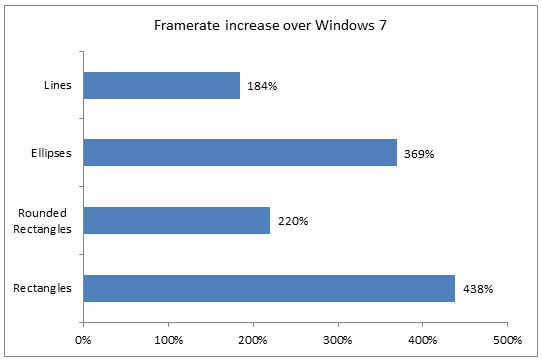Windows 8 graphics: Microsoft has hardware accelerated all the things

In what we believe to be the longest blog post ever posted on the web, Microsoft has detailed the extensive changes made to the Windows 8 graphics subsystem and DirectX 11.1. In short, everything in Windows 8 is hardware accelerated, and as a result its text, 2D, and 3D performance will blow Windows 7 away. DirectX 11.1 has also received a significant overhaul that should result in faster and more efficient games and applications.
As you can imagine, the bulk of the graphics changes in Windows 8 pertain to hardware acceleration for Metro-style apps. These apps are typographically rich and their interfaces are predominantly built out of simple geometric shapes — lines, rectangles, rounded rectangles, ellipses. In Windows 8, the rendering speed of text and simple shapes has been massively increased across the board: Title and heading text renders 336% faster than Windows 7; Lines render 184% faster; Rectangles render 438% faster; and so on and on.
The rendering of JPEG, PNG, and GIF image files has also been improved in Windows 8, mostly by expanding SIMD usage. In one demo, Windows 8 decodes and renders 64 JPEGs in 4.38 seconds, while Windows 7 performs the same task in 7.28 seconds. Faster image rendering will obviously impact almost every Windows app — especially web browsers and editing suites like Photoshop. The video [direct link] also demonstrates the text and shape rendering speed-ups.
Moving into specific changes made to DirectX 11.1, Microsoft has made it much better at redrawing portions of the screen, such as on YouTube, where only the video segment should be constantly re-rendered. By reducing redundant redrawing of text and other static elements, there is less memory and processor cycle wastage.
Also new in DirectX 11.1 are Direct2D Effects, which provide easy API access to “high-quality,” hardware-accelerated image effects, such as adjusting exposure, clarity, vibrancy, and even lens correction and advanced curves. These effects are targeted directly at Metro-style photo manipulation apps (hello, Instagram!), but presumably future versions of desktop apps like Photoshop and Gimp might also use these Direct2D Effects.
Finally, moving into developer land, Microsoft says that DirectX 11.1 will debut with a new, simplified and unified API. Microsoft has strapped a lot of new features onto DirectX since the release of DX9, and it has grown increasingly difficult to create code that makes efficient use of all these features. With DirectX 11.1, all of these features are now unified under a single API.
In all cases, faster and more efficient rendering will result in less hardware resources being used, and thus lower power consumption. In the entire cycle of Windows 8, improved efficiency and battery life are probably the strongest and most recurring themes. If the unremovable Metro Start Screen and Surface tablets wasn’t proof enough, this laser-tight focus on efficiency makes it patently clear that Microsoft’s primary concern is being competitive against Google and Apple in the mobile computing sector.
As an aside, I wouldn’t be surprised if the Xbox 720 also makes use of the tidied-up DirectX API — and of course, Windows Phone 8, by virtue of its shared Windows 8 core, will also have the same DirectX hooks. At the very least, this will make it very easy to develop games that work across all three platforms — and it also lends credence to the idea that the Xbox 720 will either run Windows 8, or at least have a shared Windows 8 core.
Copyright © 2010 Ziff Davis Publishing Holdings Inc


